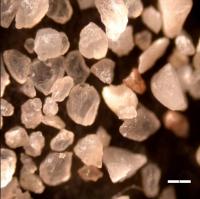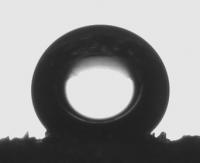Granular materials

Grains of sand create a naturally rough surface. If the grains are given a hydrophobic coating, using dichlorodimethylsilane (DCDMS) for example, the result is a superhydrophobic surface. The same can be done with glass beads. The sand or beads can be coated with different loadings of DCDMS to vary the wettability.
Note that if the sand is loose, it can coat water droplets to create liquid marbles.
‘Magic sand is sold as a children’s toy. This is sand that has been covered in a hydrophobic coating. When immersed in water, hydrophobic sand retains a layer of air around itself which we see as a silvery sheen. The sand can be sculpted underwater and when spooned out, comes out dry. Magic sand is said to have first been developed to clean up ocean oil spills. It was then used as the bedding material for laying pipes in areas that have severe winters and frozen ground.
When a fire occurs in a sandy forest, the soil can become naturally extremely water-repellent. This leads to erosion when it rains and difficulty in re-establishing vegetation. In the extreme case, it can lead to impressively destructive debris torrents. This is because the fire volatizes waxes from the litter layer on the forest floor and these then re-condense on the grains of sand. The waxes are hydrophobic, creating a naturally superhydrophobic surface.
Read more about the similarities between superhydrophobic materials and extreme soil water repellency in the publications below.

Publications
- Water repellent soil and its relationship to texture and hydrophobicity G. McHale, M.I. Newton and N.J. Shirtcliffe, Eur. J. Soil Sci. 56 (2005) 445-452
- Superhydrophobic surfaces: A model approach to predict contact angle and surface energy of soil particles J. Bachmann and G. McHale, Eur. J. Soil Sci. 60 (2009) 420-430
